2016 MXA RACE TEST: EVERYTHING YOU NEED TO KNOW ABOUT THE KTM 350SXF
Q: FIRST AND FOREMOST, IS THE 2016 KTM 350SXF BETTER THAN THE 2015 350SXF?
A: Yes, by leaps and bounds.
Q: WHAT DID KTM CHANGE FROM THE 2015 MODEL TO THE 2016 MODEL?
A: Everything. The list of changes is so long that it’s much easier to forget everything you know about the 2015 KTM 350SXF; however, since there was no 350SXF Factory Edition, it’s an unknown quantity compared to the telegraphed 250SXF and 450SXF.
Q: WHAT ARE THE 10 BIG CHANGES TO THE 2016 KTM 350SXF?
A: We are shortchanging the 2016 KTM 350SXF by only listing 10 changes, but here are the big modifications.
(1) Engine. The new 2016 350 engine shares no parts with the 2015 engine. We confess that the 88mm bore and 57.3 stroke are unchanged from last year, but the main cases are 20mm shorter and the crank 6mm higher (and 6mm shorter). The cams are lighter by 5 ounces. The cam chain is shorter, and the finger-followers are DLC-coated. The cylinder is shorter, and the CP piston is lighter. KTM’s five-speed tranny has wider gears that are surface-treated on second, third and fourth gears, while a gear position sensor changes maps to mate the ECU to whatever gear the bike is in. The number of clutch plates has been reduced from eight to seven. The new smaller starter motor is made by Mitsuba, while the LiFePO battery is from Samsung (and both reduce overall weight by 1 pound, 6 ounces).
(2) Throttle body. Eliminating the double-pulley system of previous Keihin throttle bodies, KTM’s new Direct-Connect system attaches the cables directly to the butterfly mechanism. This saves 3-1/2 ounces.
(3) Frame. The new symmetrical chromoly steel frame is 13 ounces lighter than in 2015. It is also 20 percent stiffer torsionally and 30 percent more resilient longitudinally. The head angle is 0.4 degrees steeper, and the wheelbase is 10mm shorter. KTM’s downsized aluminum subframe is 20 percent lighter than last year, and the swingarm is a 1/2-pound lighter. The seat height is lowered 10mm in the center of the saddle and 20mm at the rear end. The frame is powder-coated black instead of orange.
(4) 4CS forks. The WP 4CS forks were re-valved to make them softer. Instead of tuning them for Pro riders, who rarely race with stock forks, WP designed the valving for riders in the Vet and lower skill ranks.
(5) WP shock. KTM’s rear suspension features a larger nitrogen piggyback chamber, smaller shock shaft, and longer linkage arms that allow the shock spring to come down from 57 N/m to 48 N/m. The mid- and high-speed damping were reduced to soften the overall feel through the whole valve stack.
(6) Triple clamp. The offset on the black-anodized Neken triple clamps remains unchanged, but the bars are now rubber-mounted to reduce vibration.
 The button is the electric starter. Love it and couldn’t live without it. The black switch on the brake perch is the map switch.
The button is the electric starter. Love it and couldn’t live without it. The black switch on the brake perch is the map switch.
(7) Mapping. Although KTMs have come with optional maps for years, the maps haven’t always been easily accessible to the rider. For 2016, the Keihin ECU can be changed at the handlebars via a switch—and there is a dial in the airbox to choose which maps can be accessed through the handlebar switch. Additionally, the same handlebar-mounted switch activates KTM’s new launch control setting, which stays activated until the rider shuts the throttle off in the first turn.
(8) Radiators. KTM’s engineers totally rethought the design of traditional motorcycle radiators. Instead of just putting barn-door radiator shrouds on the side of the gas tank to direct air towards the radiators, KTM sealed off the radiators from the front, vented the airflow into channels molded into the gas tank and eliminated all restrictions that would block exiting airflow. Additionally, the black plastic radiator guards have been redesigned to double as radiator braces.
(9) Air filter. Imagine an air filter that plugs into the airbox with no wing nuts, thumb screws or clamps of any kind. You don’t have to imagine it, because KTM’s 2016 air filter cage has prongs that are diametrically opposed to each other. You stick one prong into a fitting in the airbox and hook a loop over the other one. Perfecto! Plus, no tools are required to get to the air filter.
(10) Exhaust. The 2016 exhaust has a resonance chamber built into the design. Plus, the muffler is 40mm shorter and the mass of the exhaust system is moved 60mm towards the center of gravity. The shock has to be removed to get the pipe off the bike.
Q: WHAT IS THE PIECE DE RÉSISTANCE OF THE 2016 KTM 350SXF?
A: Weight. KTM claims a weight of 223.5 pounds. We don’t know what they drained to get that weight, but on MXA’s scale the 2016 KTM 350SXF weighed 226 pounds (with all fluids and an empty gas tank). Last year’s KTM 350SXF weighed 6 pounds more. The 2016 KTM 450SXF weighs 227 pounds, and the 250SXF weighs 221 pounds. These bikes are light—and you can feel the difference.
Q: HOW DOES THE 2016 KTM 350SXF RUN ON THE DYNO?
A: It romps on the dyno. How else can you describe a 350cc engine that produces 54.41 horsepower? That is more horsepower than some 450cc motocross bikes make. At 7000 rpm, the 2016 model makes 37 horses (last year it made 35.77). At 8000 rpm, it makes 44.42 (last year it made 42.08). At 9000 rpm, it makes 49.47 (last year it made 47.74). At 10,000 rpm, it makes 50.88 (last year it made 49.37). At 11,000 rpm, it makes 53.49 (last year it made 51.93). At 12,000 rpm, it makes 53.80 (last year it made 52), and at 13,000 rpm, it makes 54.08 (last year it made 52). Peak horsepower is 54.41 at 13,200 rpm.
Simple math tells you that the 2016 engine is 1 to 2 horsepower stronger everywhere on the curve, with the biggest improvements from mid to top. Additionally, you don’t need to be Sherlock Holmes to understand that peak horsepower is in the upper reaches of the rpm range—although the 350SXF revs to 13,400 rpm, the soft rev limiter kicks in a little earlier. That means that if you don’t rev it to the moon, you don’t get the full measure of its devotion.
Q: HOW FAST IS THE 2016 KTM 350SXF?
A: MXA has been fairly steadfast in the belief that the KTM 350SXF should have more power in the midrange and give up some of its maniacal rev. We think that a peak horsepower around 11,000 rpm would be better. We even lobbied KTM to drop the 350cc size and up the displacement to 380cc to give us the grunt we wanted. All that said, the company has done a very good job of producing an easy-to-use powerband that gets its horsepower from rpm instead of cubic centimeters.
The 2016 powerband is the model of perfection. It picks up clean, builds power progressively and keeps its eye on the prize—even though that prize is nearly 14,000 rpm. Now, you might think that the increased horsepower would make the 2016 KTM 350SXF feel a lot faster than the 2015 model. Not true. Since the power increase is equalized across the board, the two powerbands mimic each other to a T. Yes, the 2016 is faster, but you can only tell that by riding the 2015 and 2016 back-to-back on the same track. While the 2016 model is more meteoric, it is also smoother, very electric and favors faultless execution over huckability.
This is not a slow bike by any means, but there is one major caveat to racing it—never shift! If you want all 54.41 horsepower, you have to milk the last drop out of it. If you shift at 9000 rpm, you will be giving up 5 horses; you must make the cows come home and dogs whine. What is cool about the progressive nature of the powerband is that it is flexible enough to meter out the correct amount of power for tricky track situations; it makes perfect half-throttle cornering power without engendering the same level of fear about breaking the tire loose as on a 450.
 Never shift. Never surrender. You gotta rev this engine to get 54 horses out of it.
Never shift. Never surrender. You gotta rev this engine to get 54 horses out of it.
Q: HOW GOOD ARE THE 4CS FORKS?
A: We applaud KTM for making a move to shake up the status quo. Of course, since KTM’s status quo is based on a decade of less-than-stellar WP forks, KTM doesn’t have much skin in the game. Over the past decade KTM forks have been too harsh for almost everyone, even though the excuse was that they were valved for fast riders. The kicker was that fast riders didn’t like them and slow riders hated them. It was a no-win situation. It was time to change directions. KTM’s American test department decided that its previous tack had sent its suspension off on the wrong course, so KTM trimmed the jib and reset the main sail. Instead of listening to its Pro test riders, KTM started listening to the Vet riders who actually buy the bikes. The result? (1) Forks that actually move all the way through their stroke. (2) Forks that have compression adjuster settings that work for a wide range of riders. (3) Forks that are plush. Okay, we admit that they aren’t stiff enough for most high-speed Pros, but they are much better for the vast majority of KTM owners.
MXA’s Pro test riders said that they could bottom the 2016 WP 4CS forks, while the typical KTM Vet rider was able to compensate by turning the compression clicker in whatever direction he wanted to go—and that is something that few KTM riders, regardless of their speed, were able to do last year. For the first time in a long time, the WP forks can operate over a wide range of compression settings. Most MXA test riders actually turned the compression clicker in instead of out.
KTM’s test department decided to focus on regular riders instead of Pro riders, who never race with stock suspension valving anyway. The WP forks aren’t perfect. They still have a long way to go, but they aren’t the worst forks in 2016—that honor belongs to some bikes with air forks. The WP forks are much better for the majority of riders who buy KTMs—but you will be happier if your send them out to be revalved for your speed..
Q: WHAT ABOUT THE REAR SHOCK?
A: We had issues with WP’s choice for the rear shock spring. The stock 48 N/m shock spring works best for riders above 180 pounds—and even then it operates with very little preload on the spring. Any rider under 180 pounds will probably have zero spring preload. This isn’t the optimum setup for a rear shock. Preload is an important tuning tool. We sent test riders of all weights out to ride with the stock 48 shock spring, and the heavier the rider, the better it worked; however, for lighter test riders r even semi-light test riders, we used the 45 N/m spring from the 2016 KTM 250SXF. This was a great mod for riders below 180 pounds. Riders in the middle of our weight range—from 160 to 180 pounds—will have to decide which spring to use based on feel.
Q: WHAT DID WE HATE?
A: The hate list:
(1) Gearing. We don’t hate the stock 50-tooth gearing, because it gives the 350SXF powerband a seamless rheostat delivery; however, with a 13,400 rpm rev limiter and peak power at the top of the chart, half of the MXA test riders preferred to add a tooth to the rear sprocket to get full use out of the high-rpm powerband. Why? Below 13,400 rpm, you aren’t using full power, so the quicker you get to max rpm, the sooner you get max blast. But if you prefer long pulling power, the stock 50 is the wise choice.
(2) Frame guards. We complained about KTM putting black frame guards on last year’s orange frame, so they fixed it for 2016. They painted the frame black. Now they match.
(3) Mud flap. It is almost as stiff as the fenders, which means that it doesn’t flap much.
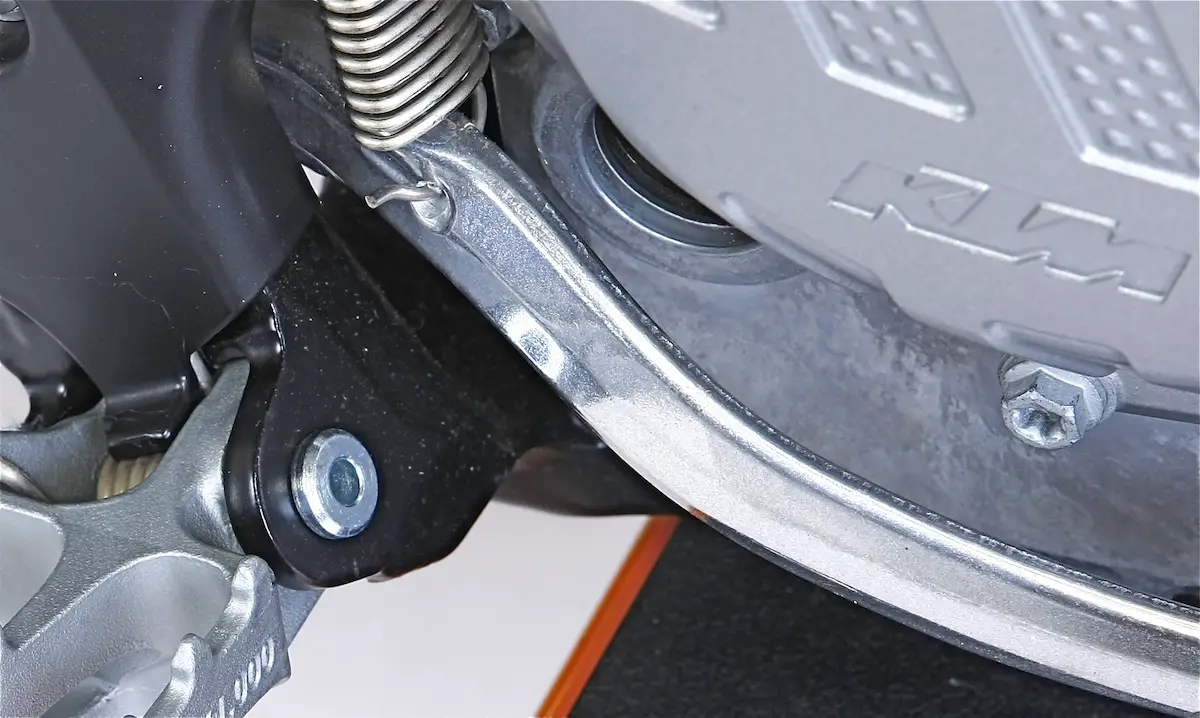 What don’t we like about this brake pedal spring. The tang sticks out of the pedal and can be hit by the rider’s boot—which will knock the brake pedal spring off. We turn the spring around so that the bottom tang faces inward.
What don’t we like about this brake pedal spring. The tang sticks out of the pedal and can be hit by the rider’s boot—which will knock the brake pedal spring off. We turn the spring around so that the bottom tang faces inward.
(4) Tubes. Expect to get flats until you replace the super-thin Pirelli tubes hidden under the Dunlop MX32 tires with something stouter.
(5) Gas cap. It sticks. Bring a friend with you to help get it off.
(6) Pipe. You can’t take the pipe off the bike without removing the shock, or you can’t take the shock off without removing the frame. Either way, this is money badly saved by KTM. They need to put a slip fit in the pipe in 2017.
(7) Sprocket bolts. Watch them—and the spoke next to the rear rim lock. They can come loose.
(8) Neutral. The KTM shifts perfectly, except when it comes to selecting neutral. We appreciate the thought behind a hard-to-find neutral on the track, but we don’t like it in the pits.
(9) Bike stand. When the 350SXF is sitting on a bike stand, the front wheel is sitting on the ground. This makes simple maintenance a hassle.
(10) Shifter tip. The Mxa gang broke several shifter tip springs, but the failures seemed to be isolated to the two-stroke KTMs.
(11) Crossbar pad. This thing shimmies and swivels while you ride. We like the design, the cover and the density of the foam, but sometimes its forward and sometimes its back. Neken, who makes the bars and triple clamps, actually makes a crossbar pad holder that doesn’t move so much.
(12) Oil line plug. The 350SXF and 250SXF have a plug in the back of the ignition cover that covers an oil port that was drilled to help the oil make a 90-degree bend inside the cases. The plug, which just blocks the hole, leaks oil. A fine mist of oil is sprayed out of the threads of the plug. Not enough oil leaks to cause mechanical problems, but it does make a mess around the shifter. This plug need to be sealed and coated with silicone…at regular intervals.
(13) Fork clickers. Although you love the ability to change the compression rebound stetting on the WP forks without having to dig in the toolbox for a screwdriver, the cog-shaped clicker needs to have longer cogs so that the clicks can be made much quicker and easier.
Q: WHAT DID WE LIKE?
A: The like list:
(1) Clutch. Honda, Yamaha, Suzuki and Kawasaki took 10 years to catch up to KTM’s braking power. How long until they build a self-adjusting, long-lasting, reliable hydraulic clutch?
(2) Electric start. Your great-grandpa used to hand-crank his car to get it started back in 1914.
(3) Handling. Once you balance the front and rear, you can go anywhere and do anything…without trying. Part of the KTM 350’s charm is its handling. Thanks to its 2016 diet, electric powerband and improved suspension, this bike can be steered with your knees.
(4) 4CS forks. WP finally valved its forks for average people. Before 2016, they were valved for someone who didn’t reside on this planet. Still, they could be a lot better.
(5) Weight. It’s thin, light and agile.
(6) Powerband. Imagine a powerband that is as smooth as silk but 2 horsepower better than last year’s 350SXF on every part of the curve.
(7) Radiator design. KTM has designed the radiators, gas tank and radiator shrouds to enhance airflow instead of impeding it. Plus, the radiator guards double as radiator braces.
(8) Air filter. The plug-and-play air filter is a very creative idea.
(9) Tires. The Dunlop MX32 tires are the best-spec’ed tires of 2016, but they are premium intermediate-terrain race tires. If you ride them on hard-pack, keep a close eye on the side knobs of the front tire. They will tear off.
Q: WHAT DO WE REALLY THINK?
A: As hard as it is to believe—considering the cutthroat world of corporations—KTM cares. KTM isn’t waiting for four years to pass before making significant improvements to its machines. KTM has kicked out the jams and changed the face of American motocross. Need proof? KTM built five totally new models for 2016. The 2016 bikes are equipped with electric starters, and they are still the lightest bikes on the track. KTM’s horsepower numbers are off the chart, yet the powerbands are smooth, flexible and totally hooked up. Everywhere you look, you can see where KTM spent the money—from the billet hubs to the easy-access air filter to the quick-release fuel line to the chromoly frame to the ODI bolt-on grips to the hydraulic clutch and the adjustable-reach levers. KTM wants you to ride their bikes so much that they even went to the trouble to build a 350cc, mid-size, Open bike to fill a gap in motocross riders’ wish lists. Good fun, great bike and an excellent company.
 MXA’S KTM 350SXF SETUP SPECS
MXA’S KTM 350SXF SETUP SPECS
This is how we set up our 2016 KTM 350SXF for racing. We offer it as a guide to help you find your own sweet spot.
4CS FORK SETTINGS
For faster test riders and bigger jumps, we turned the compression to eight clicks out. The typical Vet setting was around 15 clicks out. We think that Pro riders or fast Intermediates can still live with the stock valving by adding 10cc to the fork oil height. This will stiffen up the second half of the stroke and lessen bottoming. Very slow riders should go all the way out on the compression immediately. For hard-core racing, we recommend this fork setup on the 2016 KTM 350SXF (stock specs are in parentheses):
Spring rate: 4.8 N/m
Oil height: 100mm
Compression: 8 clicks out (15 clicks out)
Rebound: 15 clicks out
Fork leg height: 5mm up
Notes: Even our slowest test riders actually turned the clickers in on the 2016 WP 4CS forks. That’s a first. The faster the test rider, the more he was able to bottom the forks (and the farther he turned the compression clicker in). Our best settings were 20 clicks for Beginners, 15 clicks out for Novices, 8 clicks out for Intermediates and one click out for Pros.
WP SHOCK SETTINGS
KTM actually embossed a sag-scale line onto the rear fender to make sure that riders measure their race sag in the right place. We ran the race sag at 105mm as long as we could keep the free sag in the 30mm to 40mm range. If we dropped out of that window, we raised the race sag to 100mm. If you run KTM’s recommended 110mm of sag, you are very likely to encounter either free sag or spring preload issues. We increased the high-speed compression by a quarter-turn and slowed down the rebound. For hard-core racing, we recommend this shock setup for the 2016 KTM 350SXF (stock specs are in parentheses):
Spring rate: 48 N/m
Race sag: 105mm
Hi-compression: 1-3/4 turns out (2 turns out)
Lo-compression: 15 clicks out
Rebound: 10 clicks out (15 clicks out)
Notes: We use the high-speed compression damping to lessen G-outs in conjunction with more rebound than the recommended setting. We set the sag at 105mm instead of the more traditional 100mm or recommended 110mm.



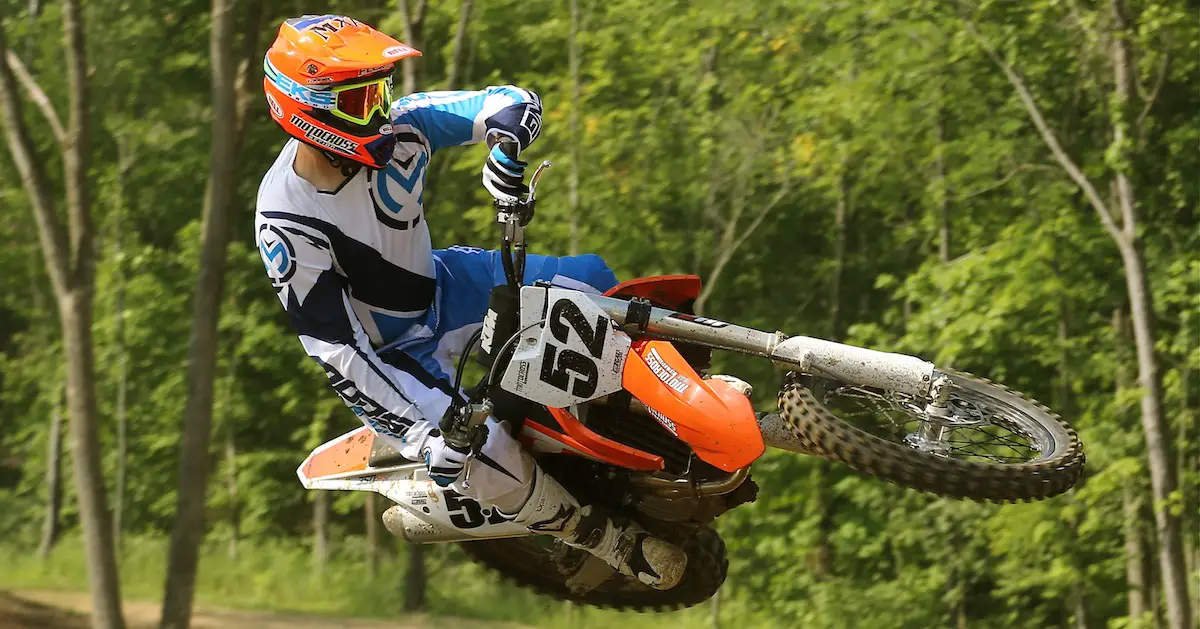

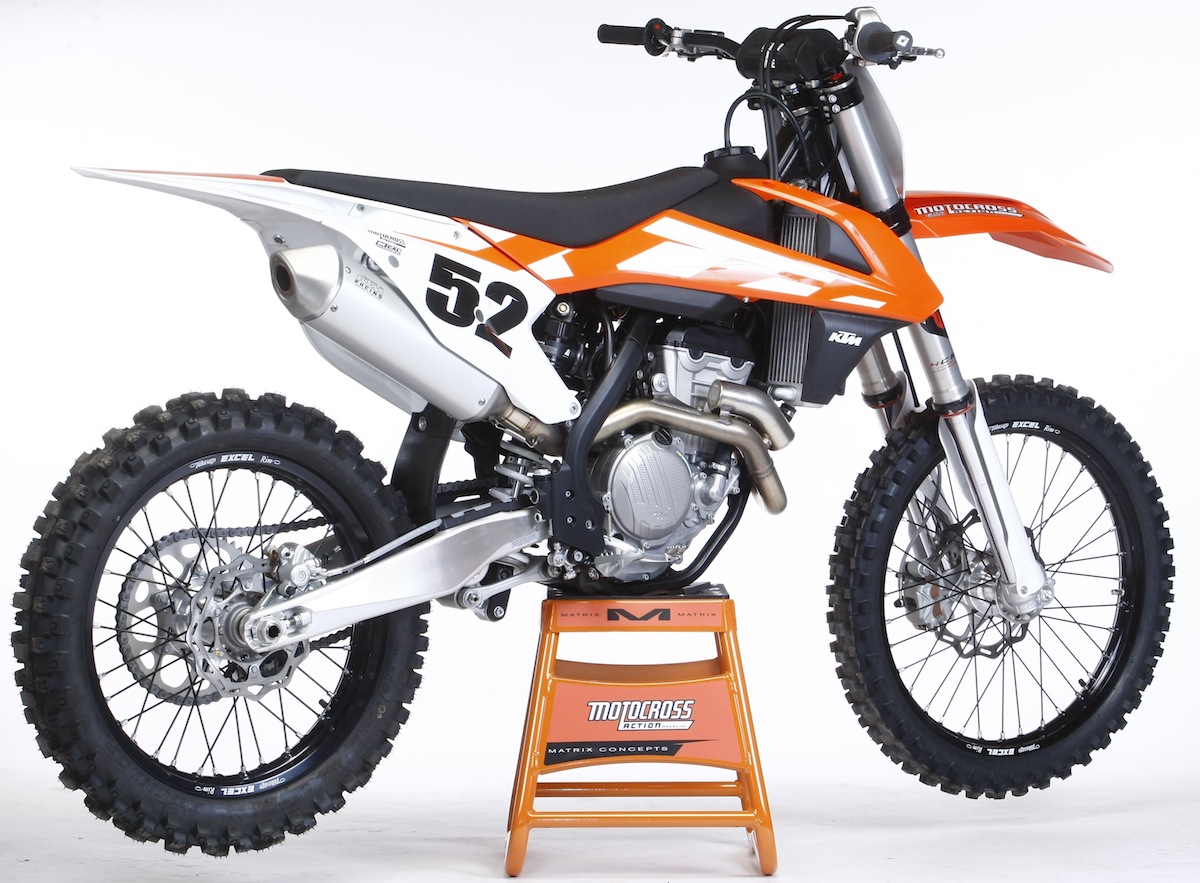




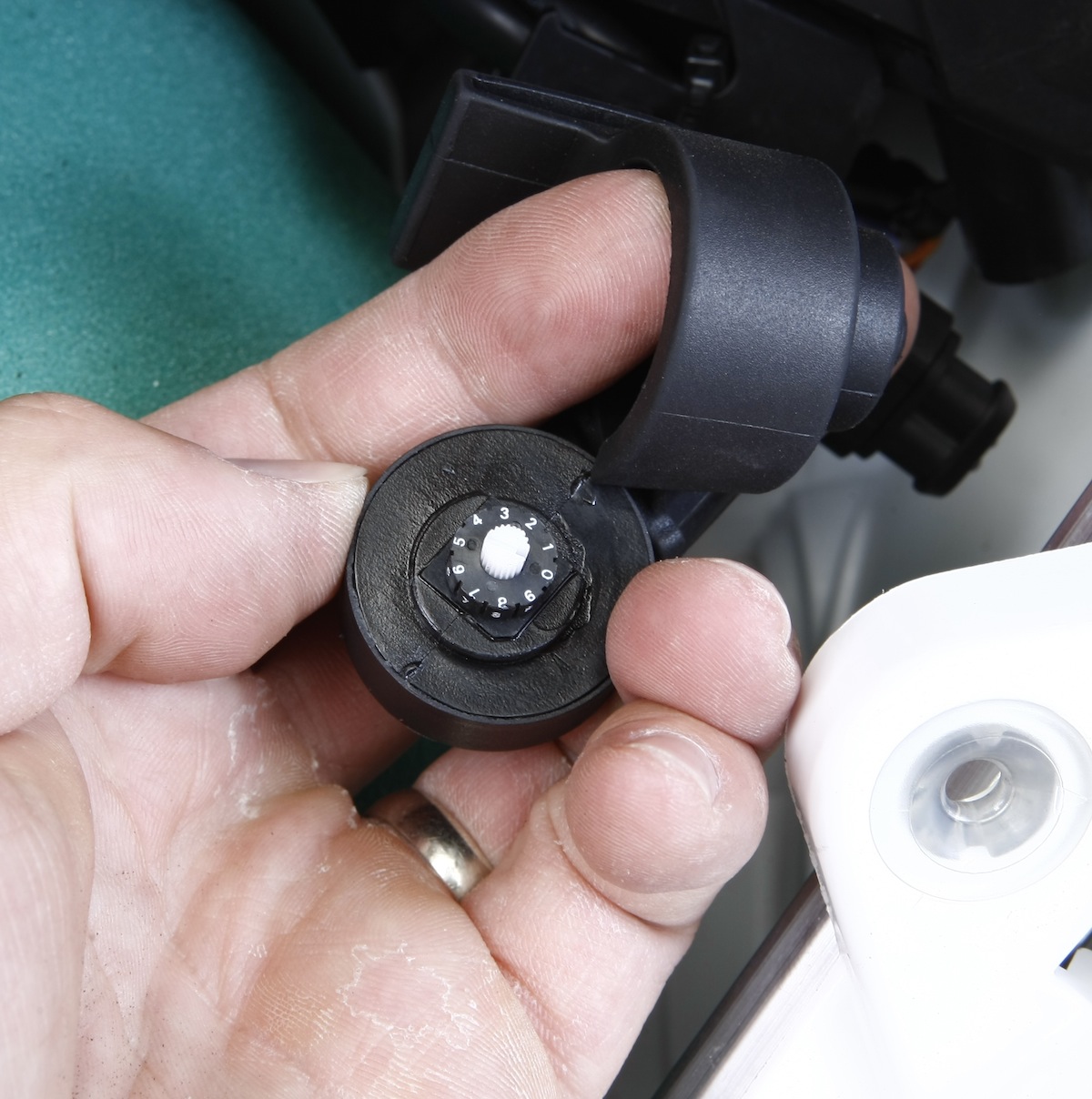
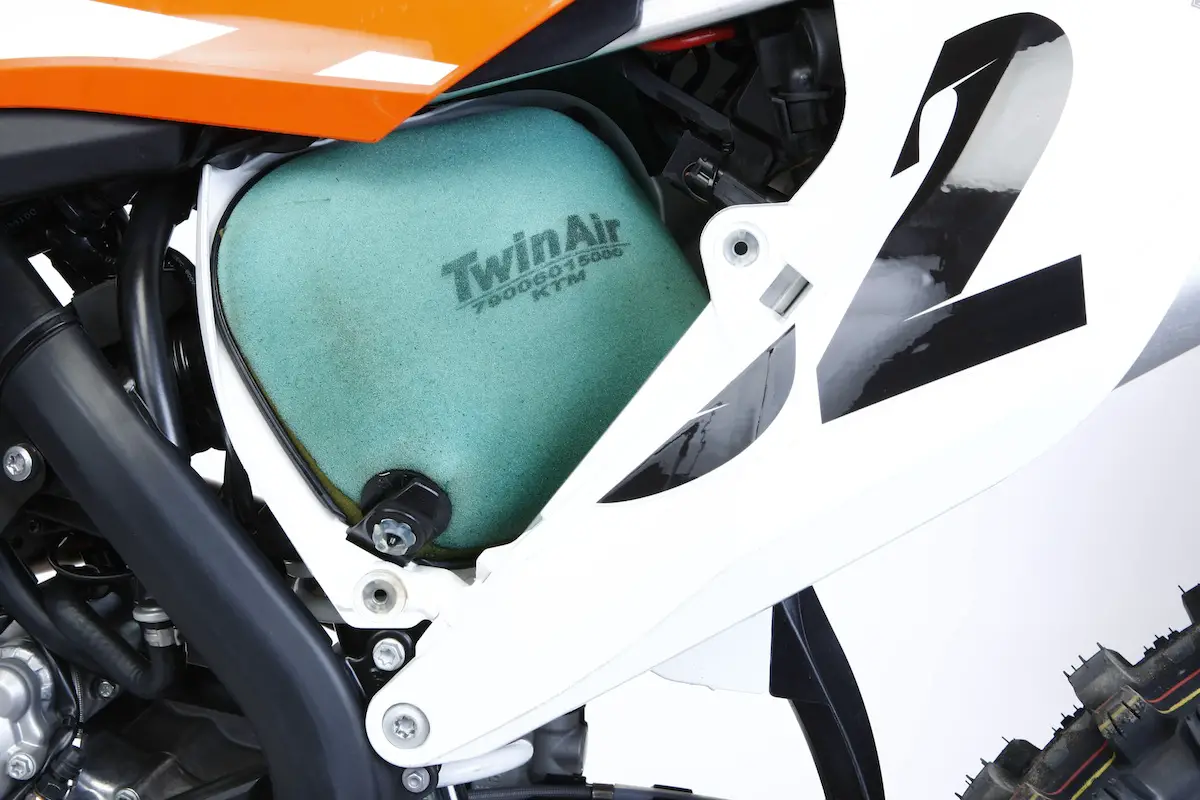



Comments are closed.